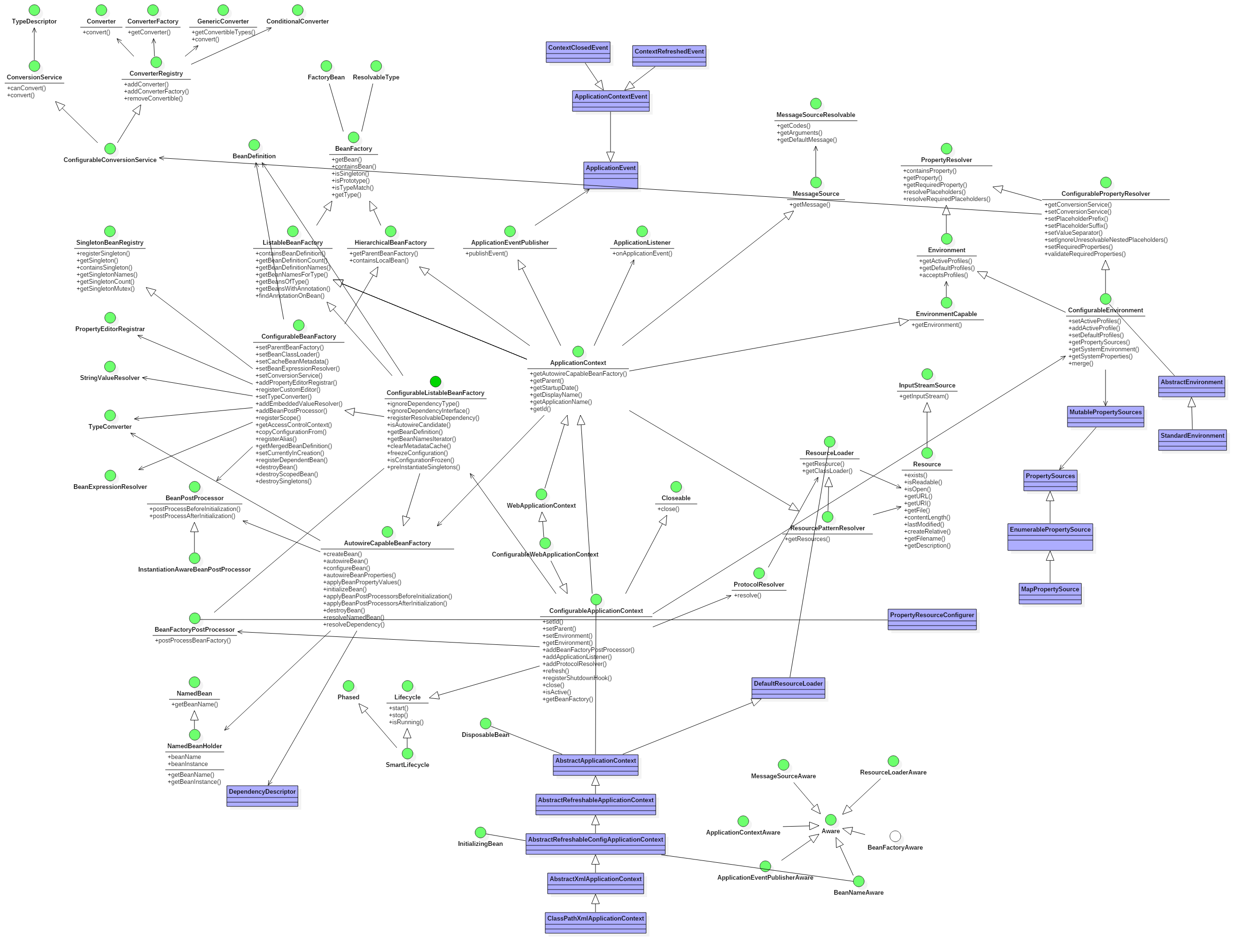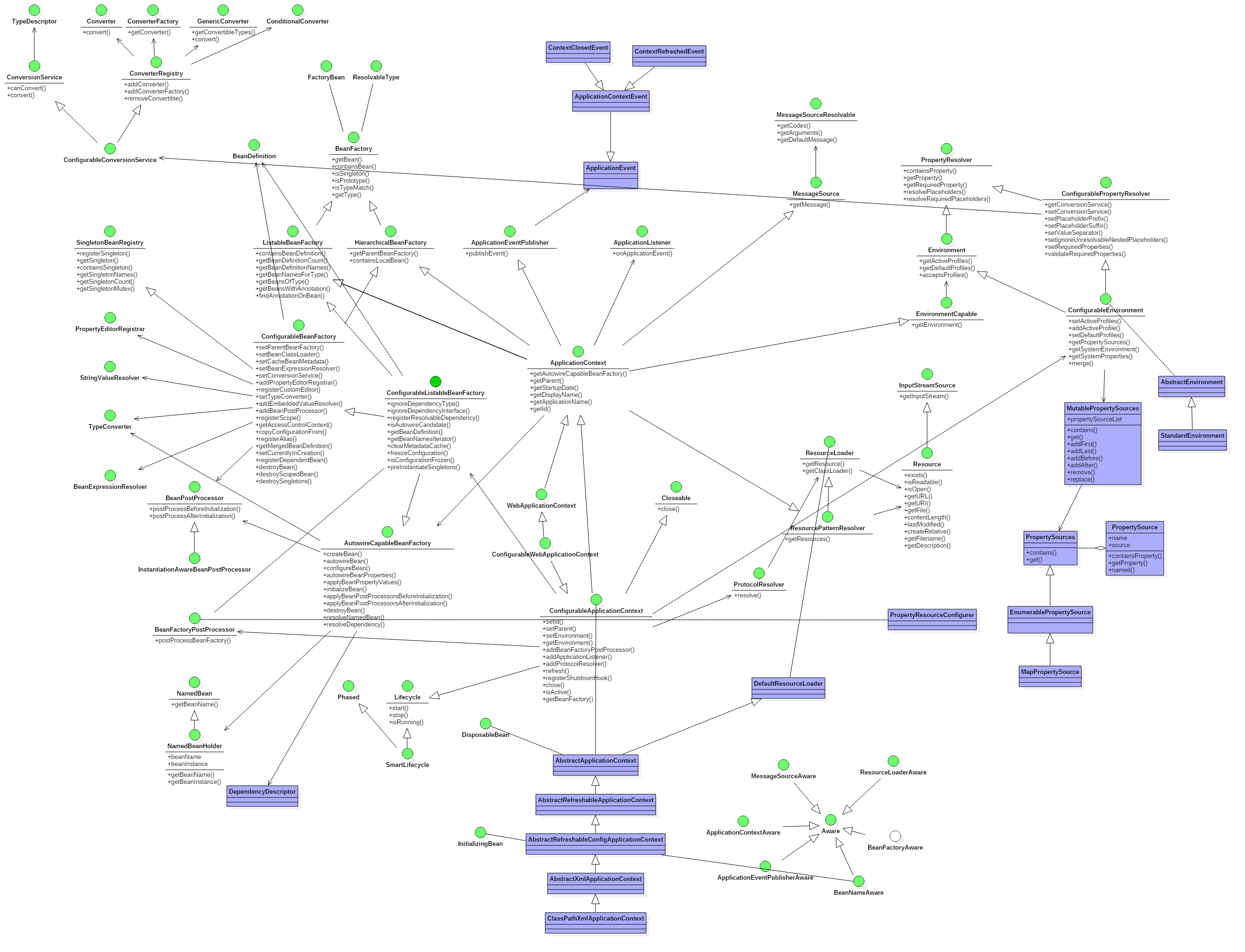MutablePropertySources定义
write by donaldhan, 2017-12-25 09:41引言
ConfigurableConversionService接口主要是用于加强 ConversionService 暴露的可读操作,为添加和移除转换器Converter提供便利,而没有提供除 ConversionService 和 ConverterRegistry 之外的操作。

在ConfigurableApplicationContext接口定义这篇文章中,我们有讲到配置环境接口 ConfigurableEnvironment ,在接口中有一个操作 getPropertySources 用于获取属性源 MutablePropertySources,今天我们就来看一下MutablePropertySources的定义。
目录
MutablePropertySources定义
由于MutablePropertySources实现了PropertySources接口我们先来看一下PropertySources接口的定义。
PropertySources
源码参见:PropertySources
package org.springframework.core.env;
/**
* PropertySources接口为包含一个或多个属性源PropertySource对象的Holder。
* @author Chris Beams
* @since 3.1
*/
public interface PropertySources extends Iterable<PropertySource<?>> {
/**
* 判断是否存在给定name对应的属性源
* @param name the {@linkplain PropertySource#getName() name of the property source} to find
*/
boolean contains(String name);
/**
* 返回给定name对应的属性源,如果没有返回null。
* @param name the {@linkplain PropertySource#getName() name of the property source} to find
*/
PropertySource<?> get(String name);
}
从上面可以看出,PropertySources(Iterable)是一个包含一个或多个属性源PropertySource对象的Holder,提供了判断是否存在给定name对应的属性源和获取给定name对应的属性源的操作。
再来看MutablePropertySources的定义。
package org.springframework.core.env;
import java.util.Iterator;
import java.util.List;
import java.util.concurrent.CopyOnWriteArrayList;
import org.apache.commons.logging.Log;
import org.apache.commons.logging.LogFactory;
/**
* PropertySources接口的默认实现,允许操作包含的属性源,提供了从一个已经存在的属性源集PropertySources实例的拷贝操作。
* 使用{@link #addFirst}和 {@link #addLast}等方法,保证属性源的优先级,属性源的优先级与添加到属性源集中的顺序有关。
*
* @author Chris Beams
* @author Juergen Hoeller
* @since 3.1
* @see PropertySourcesPropertyResolver
*/
public class MutablePropertySources implements PropertySources {
private final Log logger;
private final List<PropertySource<?>> propertySourceList = new CopyOnWriteArrayList<PropertySource<?>>();
/**
* Create a new {@link MutablePropertySources} object.
*/
public MutablePropertySources() {
this.logger = LogFactory.getLog(getClass());
}
/**
* Create a new {@code MutablePropertySources} from the given propertySources
* object, preserving the original order of contained {@code PropertySource} objects.
*/
public MutablePropertySources(PropertySources propertySources) {
this();
for (PropertySource<?> propertySource : propertySources) {
addLast(propertySource);
}
}
/**
* Create a new {@link MutablePropertySources} object and inherit the given logger,
* usually from an enclosing {@link Environment}.
*/
MutablePropertySources(Log logger) {
this.logger = logger;
}
@Override
public boolean contains(String name) {
return this.propertySourceList.contains(PropertySource.named(name));
}
@Override
public PropertySource<?> get(String name) {
int index = this.propertySourceList.indexOf(PropertySource.named(name));
return (index != -1 ? this.propertySourceList.get(index) : null);
}
@Override
public Iterator<PropertySource<?>> iterator() {
return this.propertySourceList.iterator();
}
/**
* Add the given property source object with highest precedence.
*/
public void addFirst(PropertySource<?> propertySource) {
if (logger.isDebugEnabled()) {
logger.debug("Adding PropertySource '" + propertySource.getName() + "' with highest search precedence");
}
removeIfPresent(propertySource);
this.propertySourceList.add(0, propertySource);
}
/**
* Add the given property source object with lowest precedence.
*/
public void addLast(PropertySource<?> propertySource) {
if (logger.isDebugEnabled()) {
logger.debug("Adding PropertySource '" + propertySource.getName() + "' with lowest search precedence");
}
removeIfPresent(propertySource);
this.propertySourceList.add(propertySource);
}
/**
* Add the given property source object with precedence immediately higher
* than the named relative property source.
*/
public void addBefore(String relativePropertySourceName, PropertySource<?> propertySource) {
if (logger.isDebugEnabled()) {
logger.debug("Adding PropertySource '" + propertySource.getName() +
"' with search precedence immediately higher than '" + relativePropertySourceName + "'");
}
assertLegalRelativeAddition(relativePropertySourceName, propertySource);
removeIfPresent(propertySource);
int index = assertPresentAndGetIndex(relativePropertySourceName);
addAtIndex(index, propertySource);
}
/**
* Add the given property source object with precedence immediately lower
* than the named relative property source.
*/
public void addAfter(String relativePropertySourceName, PropertySource<?> propertySource) {
if (logger.isDebugEnabled()) {
logger.debug("Adding PropertySource '" + propertySource.getName() +
"' with search precedence immediately lower than '" + relativePropertySourceName + "'");
}
assertLegalRelativeAddition(relativePropertySourceName, propertySource);
removeIfPresent(propertySource);
int index = assertPresentAndGetIndex(relativePropertySourceName);
addAtIndex(index + 1, propertySource);
}
/**
* Return the precedence of the given property source, {@code -1} if not found.
*/
public int precedenceOf(PropertySource<?> propertySource) {
return this.propertySourceList.indexOf(propertySource);
}
/**
* Remove and return the property source with the given name, {@code null} if not found.
* @param name the name of the property source to find and remove
*/
public PropertySource<?> remove(String name) {
if (logger.isDebugEnabled()) {
logger.debug("Removing PropertySource '" + name + "'");
}
int index = this.propertySourceList.indexOf(PropertySource.named(name));
return (index != -1 ? this.propertySourceList.remove(index) : null);
}
/**
* Replace the property source with the given name with the given property source object.
* @param name the name of the property source to find and replace
* @param propertySource the replacement property source
* @throws IllegalArgumentException if no property source with the given name is present
* @see #contains
*/
public void replace(String name, PropertySource<?> propertySource) {
if (logger.isDebugEnabled()) {
logger.debug("Replacing PropertySource '" + name + "' with '" + propertySource.getName() + "'");
}
int index = assertPresentAndGetIndex(name);
this.propertySourceList.set(index, propertySource);
}
/**
* Return the number of {@link PropertySource} objects contained.
*/
public int size() {
return this.propertySourceList.size();
}
@Override
public String toString() {
return this.propertySourceList.toString();
}
/**
* Ensure that the given property source is not being added relative to itself.
*/
protected void assertLegalRelativeAddition(String relativePropertySourceName, PropertySource<?> propertySource) {
String newPropertySourceName = propertySource.getName();
if (relativePropertySourceName.equals(newPropertySourceName)) {
throw new IllegalArgumentException(
"PropertySource named '" + newPropertySourceName + "' cannot be added relative to itself");
}
}
/**
* Remove the given property source if it is present.
*/
protected void removeIfPresent(PropertySource<?> propertySource) {
this.propertySourceList.remove(propertySource);
}
/**
* Add the given property source at a particular index in the list.
*/
private void addAtIndex(int index, PropertySource<?> propertySource) {
removeIfPresent(propertySource);
this.propertySourceList.add(index, propertySource);
}
/**
* Assert that the named property source is present and return its index.
* @param name {@linkplain PropertySource#getName() name of the property source} to find
* @throws IllegalArgumentException if the named property source is not present
*/
private int assertPresentAndGetIndex(String name) {
int index = this.propertySourceList.indexOf(PropertySource.named(name));
if (index == -1) {
throw new IllegalArgumentException("PropertySource named '" + name + "' does not exist");
}
return index;
}
}
从上面可以看出,MutablePropertySources为属性源Holder PropertySource的具体实现,内部通过一个属性源集合(CopyOnWriteArrayList)来管理内部的属性源, 主要提供添加、移除、替换、是否包含属性源操作,这些操作实际上通过 CopyOnWriteArrayList 的相应操作完成。
PropertySource
源码参见:PropertySource
package org.springframework.core.env;
import org.apache.commons.logging.Log;
import org.apache.commons.logging.LogFactory;
import org.springframework.util.Assert;
import org.springframework.util.ObjectUtils;
/**
* Abstract base class representing a source of name/value property pairs. The underlying
* {@linkplain #getSource() source object} may be of any type {@code T} that encapsulates
* properties. Examples include {@link java.util.Properties} objects, {@link java.util.Map}
* objects, {@code ServletContext} and {@code ServletConfig} objects (for access to init
* parameters). Explore the {@code PropertySource} type hierarchy to see provided
* implementations.
*抽象基础类属性源PropertySource是一个表示属性值对的源。通过 {@linkplain #getSource() source object}获取的属性源,
*可以是任何底层封装了属性的属性源。比如{@link java.util.Properties},{@link java.util.Map},{@code ServletContext},
*{@code ServletConfig}(访问初始化参数)对象。更多,查看属性源的实现。
* <p>{@code PropertySource} objects are not typically used in isolation, but rather
* through a {@link PropertySources} object, which aggregates property sources and in
* conjunction with a {@link PropertyResolver} implementation that can perform
* precedence-based searches across the set of {@code PropertySources}.
*属性对象PropertySource,一般不单独使用,而在通过PropertySources,属性源集PropertySources,可以聚合属性,
*同时使用PropertyResolver实现,执行跨属性源的基于优先级的搜索。
* <p>{@code PropertySource} identity is determined not based on the content of
* encapsulated properties, but rather based on the {@link #getName() name} of the
* {@code PropertySource} alone. This is useful for manipulating {@code PropertySource}
* objects when in collection contexts. See operations in {@link MutablePropertySources}
* as well as the {@link #named(String)} and {@link #toString()} methods for details.
*PropertySource的特质,决定了不能基于内容封装属性,但是可以基于name{@link #getName() name}。
*在集合上下文中,这种方式非常有用。具体操作参见{@link MutablePropertySources},及{@link #named(String)} and {@link #toString()}
*方法。
* <p>Note that when working with @{@link
* org.springframework.context.annotation.Configuration Configuration} classes that
* the @{@link org.springframework.context.annotation.PropertySource PropertySource}
* annotation provides a convenient and declarative way of adding property sources to the
* enclosing {@code Environment}.
*注意:当使用注解配置@{@linkorg.springframework.context.annotation.Configuration Configuration}时,
* @{@link org.springframework.context.annotation.PropertySource PropertySource}注解为
* 声明和添加属性源到环境配置Environment,提供了便利。
*
* @author Chris Beams
* @since 3.1
* @see PropertySources
* @see PropertyResolver
* @see PropertySourcesPropertyResolver
* @see MutablePropertySources
* @see org.springframework.context.annotation.PropertySource
*/
public abstract class PropertySource<T> {
protected final Log logger = LogFactory.getLog(getClass());
protected final String name;
protected final T source;
/**
* Create a new {@code PropertySource} with the given name and source object.
*/
public PropertySource(String name, T source) {
Assert.hasText(name, "Property source name must contain at least one character");
Assert.notNull(source, "Property source must not be null");
this.name = name;
this.source = source;
}
/**
* Create a new {@code PropertySource} with the given name and with a new
* {@code Object} instance as the underlying source.
* <p>Often useful in testing scenarios when creating anonymous implementations
* that never query an actual source but rather return hard-coded values.
*/
@SuppressWarnings("unchecked")
public PropertySource(String name) {
this(name, (T) new Object());
}
/**
* Return the name of this {@code PropertySource}
* 获取属性源的name
*/
public String getName() {
return this.name;
}
/**
* Return the underlying source object for this {@code PropertySource}.
* 返回底层属性源对象
*/
public T getSource() {
return this.source;
}
/**
* Return whether this {@code PropertySource} contains the given name.
* <p>This implementation simply checks for a {@code null} return value
* from {@link #getProperty(String)}. Subclasses may wish to implement
* a more efficient algorithm if possible.
* 判断当前属性源是否包含给定name对应的属性。当前实现根据检查{@link #getProperty(String)}方法获取的属性,
* 是否为空。子类可以重写这个方法。
*
* @param name the property name to find
*/
public boolean containsProperty(String name) {
return (getProperty(name) != null);
}
/**
* Return the value associated with the given name,
* or {@code null} if not found.
* 返回当前属性源是否包含给定name对应的属性,没有返回null
* @param name the property to find
* @see PropertyResolver#getRequiredProperty(String)
*/
public abstract Object getProperty(String name);
/**
* This {@code PropertySource} object is equal to the given object if:
* <ul>
* <li>they are the same instance
* <li>the {@code name} properties for both objects are equal
* </ul>
* <p>No properties other than {@code name} are evaluated.
*/
@Override
public boolean equals(Object obj) {
return (this == obj || (obj instanceof PropertySource &&
ObjectUtils.nullSafeEquals(this.name, ((PropertySource<?>) obj).name)));
}
/**
* Return a hash code derived from the {@code name} property
* of this {@code PropertySource} object.
*/
@Override
public int hashCode() {
return ObjectUtils.nullSafeHashCode(this.name);
}
/**
* Produce concise output (type and name) if the current log level does not include
* debug. If debug is enabled, produce verbose output including the hash code of the
* PropertySource instance and every name/value property pair.
* <p>This variable verbosity is useful as a property source such as system properties
* or environment variables may contain an arbitrary number of property pairs,
* potentially leading to difficult to read exception and log messages.
* @see Log#isDebugEnabled()
*/
@Override
public String toString() {
if (logger.isDebugEnabled()) {
return getClass().getSimpleName() + "@" + System.identityHashCode(this) +
" {name='" + this.name + "', properties=" + this.source + "}";
}
else {
return getClass().getSimpleName() + " {name='" + this.name + "'}";
}
}
/**
* Return a {@code PropertySource} implementation intended for collection comparison purposes only.
* 返回一个用于集合比较的属性源实现ComparisonPropertySource。
* <p>Primarily for internal use, but given a collection of {@code PropertySource} objects, may be
* used as follows:
* 主要是内部使用,但是给定的属性源集合对象,可能为如下:
* <pre class="code">
* {@code List<PropertySource<?>> sources = new ArrayList<PropertySource<?>>();
* sources.add(new MapPropertySource("sourceA", mapA));
* sources.add(new MapPropertySource("sourceB", mapB));
* assert sources.contains(PropertySource.named("sourceA"));
* assert sources.contains(PropertySource.named("sourceB"));
* assert !sources.contains(PropertySource.named("sourceC"));
* }</pre>
* The returned {@code PropertySource} will throw {@code UnsupportedOperationException}
* if any methods other than {@code equals(Object)}, {@code hashCode()}, and {@code toString()}
* are called.
* 如果调用{@code equals(Object)}, {@code hashCode()}, and {@code toString()之外的任何方法,将会抛出
* UnsupportedOperationException异常
* @param name the name of the comparison {@code PropertySource} to be created and returned.
*/
public static PropertySource<?> named(String name) {
return new ComparisonPropertySource(name);
}
/**
* {@code PropertySource} to be used as a placeholder in cases where an actual
* property source cannot be eagerly initialized at application context
* creation time. For example, a {@code ServletContext}-based property source
* must wait until the {@code ServletContext} object is available to its enclosing
* {@code ApplicationContext}. In such cases, a stub should be used to hold the
* intended default position/order of the property source, then be replaced
* during context refresh.
* 在应用上下文创建时,属性源不能够初始化的情况下,StubPropertySource属性源可以作为占位符使用。
* 比如基于{@code ServletContext}的属性源必须等待应用上下文内部封装的{@code ServletContext}对象可用。
* 在这种情况下,存根属性源StubPropertySource,用于保持属性的位置顺序,当上下文刷新时,再替换。
* @see org.springframework.context.support.AbstractApplicationContext#initPropertySources()
* @see org.springframework.web.context.support.StandardServletEnvironment
* @see org.springframework.web.context.support.ServletContextPropertySource
*/
public static class StubPropertySource extends PropertySource<Object> {
public StubPropertySource(String name) {
super(name, new Object());
}
/**
* Always returns {@code null}.
*/
@Override
public String getProperty(String name) {
return null;
}
}
/**
* @see PropertySource#named(String)
*/
static class ComparisonPropertySource extends StubPropertySource {
private static final String USAGE_ERROR =
"ComparisonPropertySource instances are for use with collection comparison only";
public ComparisonPropertySource(String name) {
super(name);
}
@Override
public Object getSource() {
throw new UnsupportedOperationException(USAGE_ERROR);
}
@Override
public boolean containsProperty(String name) {
throw new UnsupportedOperationException(USAGE_ERROR);
}
@Override
public String getProperty(String name) {
throw new UnsupportedOperationException(USAGE_ERROR);
}
}
}
从上面可以看出,属性抽象类PropertySource,可以理解底层属性源source的封装类,提供了获取属性值,及判断属性值是否存在的操作,同时提供了包装属性源为不可读属性源ComparisonPropertySource操作。PropertySource属性不能单独使用,要配合属性源集PropertySources(Iterable)使用。
最后以MutablePropertySources的类图结束这篇文章。

总结
PropertySources(Iterable)是一个包含一个或多个属性源PropertySource对象的Holder,提供了判断是否存在给定name对应的属性源和获取给定name对应的属性源的操作。
MutablePropertySources为属性源Holder PropertySource的具体实现,内部通过一个属性源集合(CopyOnWriteArrayList)来管理内部的属性源, 主要提供添加、移除、替换、是否包含属性源操作,这些操作实际上通过 CopyOnWriteArrayList 的相应操作完成。
属性抽象类PropertySource,可以理解底层属性源source的封装类,提供了获取属性值,及判断属性值是否存在的操作,同时提供了包装属性源为不可读属性源ComparisonPropertySource操作。PropertySource属性不能单独使用,要配合属性源集PropertySources(Iterable)使用。